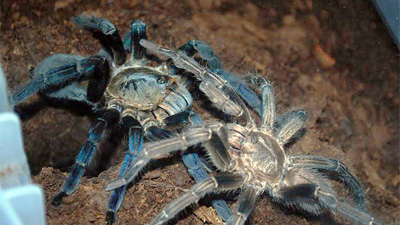Are Cobalt Blue Tarantulas Suitable for Beginners?

Photo by Julian Schultz on Unsplash
Tarantulas have long fascinated enthusiasts with their unique features and captivating behaviors. Among the diverse range of tarantula species available, cobalt blue tarantulas (Haplopelma lividum) stand out with their stunning metallic blue coloration and striking appearance.
However, for beginners entering the world of tarantula keeping, the question arises: Are cobalt Blue Tarantulas suitable for novices?
In this article, we will explore the factors to consider when contemplating cobalt blue tarantulas as pets for beginners.
Understanding Cobalt Blue Tarantulas
The cobalt blue tarantula, scientifically known as Cyriopagopus lividus, is a medium-sized tarantula species with a leg span of around 13 cm. It is native to southeast Asia (such as Thailand, Myanmar, and Cambodia) and is known for its striking appearance, characterized by iridescent blue legs and a light gray prosoma and opisthosoma. The opisthosoma may also contain darker gray chevrons.
Cobalt blue tarantulas have a lifespan of up to 25 years in captivity for females and up to 10 years for males. In the wild, they can live up to 30 years for females and 20 years for males. It is important to note that the females have a longer lifespan compared to males.
They are fossorial species, which means they spend much of their time in deep burrows that provide them with security and stability. In their natural habitat, they primarily emerge at night to hunt for prey.
Temperament and Aggression
These tarantulas are known for their defensive and aggressive behavior, particularly when they feel threatened or cornered. They may exhibit defensive behaviors such as rearing up, flicking urticating hairs, or biting as a means of self-defense. For beginners, the temperamental nature of cobalt blues can present challenges, as they require more careful and patient handling compared to other, more docile tarantula species.
It's important to note that the venom of the cobalt blue tarantula can cause discomfort and pain when bitten. The venom of tarantulas is not considered life-threatening to humans but can cause allergic reactions, including swelling, redness, and itching. Therefore, it is crucial to handle cobalt blue tarantulas with caution and to avoid unnecessary handling or provocation to prevent any potential bites.
Care Requirements
Beginners should be prepared to invest time and effort into creating a suitable habitat and maintaining optimal conditions for their pet Cobalt Blue Tarantula.
Here are some key care requirements for cobalt blue tarantulas:
1. Enclosure Setup
A spacious terrarium with ample substrate for burrowing is ideal, as these tarantulas are primarily fossorial. The substrate should be kept slightly moist to maintain humidity levels, and hiding spots and climbing structures should be provided to allow for natural behaviors. Ventilation is also crucial to prevent the buildup of excess moisture, which can lead to respiratory issues.
2. Temperature and Humidity
Maintaining proper temperature and humidity levels is critical for the health of Cobalt Blue Tarantulas. They prefer warm temperatures ranging from 75°F to 85°F and moderate to high humidity levels of 70% to 80%. It's essential to monitor these conditions regularly and make adjustments as needed to ensure the comfort and well-being of your pet tarantula.
3. Feeding and Nutrition
Cobalt Blue Tarantulas are carnivorous predators, feeding primarily on live insects such as crickets, roaches, and mealworms. Adult tarantulas should be fed once or twice a week, while juveniles may require more frequent feeding. It's essential to offer appropriately sized prey items and remove any uneaten food promptly to prevent spoilage and maintain cleanliness in the enclosure.
4. Handling and Interaction
Handling Cobalt Blue Tarantulas should be approached with caution, especially for beginners. While they are not inherently aggressive, they may exhibit defensive behaviors when threatened or startled. It's crucial to respect the tarantula's space and boundaries and avoid unnecessary handling or disturbance. Observation can be done from a distance to appreciate the tarantula's beauty and behavior without causing stress or risk of injury.
If handling becomes necessary for maintenance or rehousing purposes, it should be done with extreme caution and only by experienced handlers. Wearing protective gloves and using appropriate tools, such as a catching cup or soft paintbrush, can help minimize the risk of injury to both the tarantula and the handler.
Alternative Species for Beginners
For those new to tarantula keeping, it may be more suitable to start with less aggressive and more manageable species. Several tarantula species are known for their calm temperament and are considered better choices for beginners.
Mexican redknee tarantulas (Brachypelma smithi), Chilean rose tarantulas (Grammostola rosea), and Costa Rican zebra tarantulas (Aphonopelma seemanni) are popular examples of more beginner-friendly species.
These tarantulas are generally less aggressive and more tolerant of handling, making them ideal for those who are just starting their journey into tarantula keeping.
Conclusion
In summary, it is not recommended for beginners to keep cobalt blue tarantulas (Cyriopagopus lividus).
Cobalt blue tarantulas have a feisty and defensive nature, making them quick to bite or stand their ground when threatened. Their aggression and defensive behavior can pose a challenge for novice keepers who may not have the experience or confidence to handle them safely.
Furthermore, cobalt blue tarantulas have specific care requirements that may be more challenging for beginners to meet. They require appropriate housing, including a tank of at least 15 gallons, proper temperature and humidity levels, regular cleaning, and observation of potential health issues. Meeting these specific care needs can be more demanding for beginners who are still learning about tarantula care.
For beginners who are interested in keeping tarantulas, it is generally recommended to start with more docile and beginner-friendly species. Tarantulas like Mexican redknee tarantulas (Brachypelma smithi), Chilean rose tarantulas (Grammostola rosea), and Costa Rican zebra tarantulas (Aphonopelma seemanni) are often suggested as good choices for beginners due to their calmer temperament and relatively easier care requirements.
You May Also Like
 Other Pets50 Popular Names for Tarantulas (with Meaing)
Other Pets50 Popular Names for Tarantulas (with Meaing) Other PetsThe Price of Cobalt Blue Tarantula in the US ($50 to $200)
Other PetsThe Price of Cobalt Blue Tarantula in the US ($50 to $200) Other Pets6 Best Tarantula Species for Beginners
Other Pets6 Best Tarantula Species for Beginners Other PetsWhat Happens if a Cobalt Blue Tarantula Bites You?
Other PetsWhat Happens if a Cobalt Blue Tarantula Bites You? Other PetsWhat Happens if a Pink Toe Tarantula Bites You?
Other PetsWhat Happens if a Pink Toe Tarantula Bites You? Other PetsWhat Happens if a Rose Hair Tarantula Bites You?
Other PetsWhat Happens if a Rose Hair Tarantula Bites You?